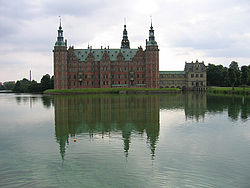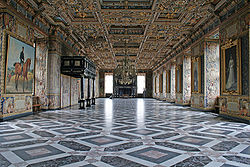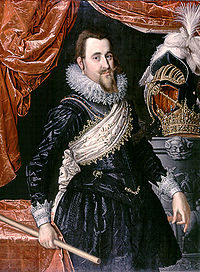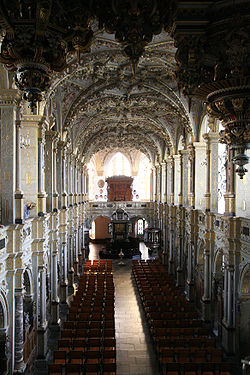
Frederiksborg Palace
Encyclopedia


Castle
A castle is a type of fortified structure built in Europe and the Middle East during the Middle Ages by European nobility. Scholars debate the scope of the word castle, but usually consider it to be the private fortified residence of a lord or noble...
in Hillerød
Hillerød
Hillerød Kommune is a municipality in Region Hovedstaden . The municipality covers an area of 191 km² , and has a total population of 46,568...
, Denmark
Denmark
Denmark is a Scandinavian country in Northern Europe. The countries of Denmark and Greenland, as well as the Faroe Islands, constitute the Kingdom of Denmark . It is the southernmost of the Nordic countries, southwest of Sweden and south of Norway, and bordered to the south by Germany. Denmark...
. It was built as a royal residence for King Christian IV
Christian IV of Denmark
Christian IV was the king of Denmark-Norway from 1588 until his death. With a reign of more than 59 years, he is the longest-reigning monarch of Denmark, and he is frequently remembered as one of the most popular, ambitious and proactive Danish kings, having initiated many reforms and projects...
, and is now known as The Museum of National History. The current building replaced a previous castle erected by Frederick II
Frederick II of Denmark
Frederick II was King of Denmark and Norway and duke of Schleswig from 1559 until his death.-King of Denmark:Frederick II was the son of King Christian III of Denmark and Norway and Dorothea of Saxe-Lauenburg. Frederick II stands as the typical renaissance ruler of Denmark. Unlike his father, he...
, and is the largest Renaissance
Renaissance
The Renaissance was a cultural movement that spanned roughly the 14th to the 17th century, beginning in Italy in the Late Middle Ages and later spreading to the rest of Europe. The term is also used more loosely to refer to the historical era, but since the changes of the Renaissance were not...
palace
Palace
A palace is a grand residence, especially a royal residence or the home of a head of state or some other high-ranking dignitary, such as a bishop or archbishop. The word itself is derived from the Latin name Palātium, for Palatine Hill, one of the seven hills in Rome. In many parts of Europe, the...
in Scandinavia
Scandinavia
Scandinavia is a cultural, historical and ethno-linguistic region in northern Europe that includes the three kingdoms of Denmark, Norway and Sweden, characterized by their common ethno-cultural heritage and language. Modern Norway and Sweden proper are situated on the Scandinavian Peninsula,...
. The palace is located on three small islands in the middle of Palace Lake, (Danish
Danish language
Danish is a North Germanic language spoken by around six million people, principally in the country of Denmark. It is also spoken by 50,000 Germans of Danish ethnicity in the northern parts of Schleswig-Holstein, Germany, where it holds the status of minority language...
, Slotsøen), and is adjoined by a large, baroque
Baroque
The Baroque is a period and the style that used exaggerated motion and clear, easily interpreted detail to produce drama, tension, exuberance, and grandeur in sculpture, painting, literature, dance, and music...
formal garden.
History

Castle
A castle is a type of fortified structure built in Europe and the Middle East during the Middle Ages by European nobility. Scholars debate the scope of the word castle, but usually consider it to be the private fortified residence of a lord or noble...
date back to 1560, and were built by King Frederick II
Frederick II of Denmark
Frederick II was King of Denmark and Norway and duke of Schleswig from 1559 until his death.-King of Denmark:Frederick II was the son of King Christian III of Denmark and Norway and Dorothea of Saxe-Lauenburg. Frederick II stands as the typical renaissance ruler of Denmark. Unlike his father, he...
, after whom the palace is named.
Most of the current palace, however, was built from 1602 to 1620 by Christian IV using Flemish architects, Hans
Hans van Steenwinckel the Younger
Hans van Steenwinckel the Younger was a Flemish-Danish architect who specialised in the Dutch Renaissance style, typical of prestigious Danish buildings from the first half of the 17th century...
and Lorenz van Steenwinckel
Lorenz van Steenwinckel
Lorenz van Steenwinckel was a Flemish-Danish architect and sculptor, son of Hans van Steenwinckel the Elder and brother of Hans van Steenwinckel the Younger. From 1613, he was responsible for numerous projects commissioned by Christian IV...
, and follows the Dutch style favoured by Christian IV for his new buildings in Copenhagen
Copenhagen
Copenhagen is the capital and largest city of Denmark, with an urban population of 1,199,224 and a metropolitan population of 1,930,260 . With the completion of the transnational Øresund Bridge in 2000, Copenhagen has become the centre of the increasingly integrating Øresund Region...
.
After Christian IV's death in 1648, the palace was used mainly for ceremonial events, primarily the anointing and crowning
Coronation
A coronation is a ceremony marking the formal investiture of a monarch and/or their consort with regal power, usually involving the placement of a crown upon their head and the presentation of other items of regalia...
of the Absolute Monarchs in the palace church. The following Danish kings and queens were crowned here:
- 1671: Christian V and Charlotte Amalie of Hesse-Kassel
- 1700: Frederick IV and Louise of Mecklenburg-Güstrow
- 1721: Anna Sophia, consort of Frederick IV
- 1731: Christian VI and Sophia Magdalena of Brandenburg-Kulmbach
- 1747: Frederick V and Louise of Great Britain
- 1752: Juliana Maria of Brunswick-Wolfenbüttel, consort of Frederick V
- 1815: Frederick VI and Marie of Hesse-Kassel
- 1840: Christian VIII and Caroline Amalie of Schleswig-Holstein
Since 1693 the church has also been used as Knight's Chapel for the Order of the Elephant
Order of the Elephant
The Order of the Elephant is the highest order of Denmark. It has origins in the 15th century, but has officially existed since 1693, and since the establishment of constitutional monarchy in 1849, is now almost exclusively bestowed on royalty and heads of state.- History :A Danish religious...
and the Order of the Dannebrog
Order of the Dannebrog
The Order of the Dannebrog is an Order of Denmark, instituted in 1671 by Christian V. It resulted from a move in 1660 to break the absolutism of the nobility. The Order was only to comprise 50 noble Knights in one class plus the Master of the Order, i.e. the Danish monarch, and his sons...
.
The palace was also used to house the royal family's art collection; as a result, it came to be regarded as a national monument.
In 1720, the Treaty of Frederiksborg
Treaty of Frederiksborg
The Treaty of Frederiksborg refers to the treaty signed at Frederiksborg Palace on 3 July 1720 that ended the Great Northern War between Sweden and Denmark-Norway. Sweden paid 600,000 Riksdaler in damages, broke the alliance with Holstein and forfeited its right to duty free passage of Öresund...
was signed here.
In 1850s, the palace was again used as a residence by King Frederick VII
Frederick VII of Denmark
Frederick VII was a King of Denmark. He reigned from 1848 until his death. He was the last Danish monarch of the older Royal branch of the House of Oldenburg and also the last king of Denmark to rule as an absolute monarch...
. During the night of December 16–17, 1859, while he was in residence, a fire destroyed a large part of the main palace's interior. Reconstruction was funded by public subscription, with large contributions from the King, state and the prominent philanthropist
Philanthropist
A philanthropist is someone who engages in philanthropy; that is, someone who donates his or her time, money, and/or reputation to charitable causes...
J. C. Jacobsen of Carlsberg Brewery, who also provided funds to establish the The Museum of National History that now occupies Frederiksborg. A large collection of notable paintings by the Danish painter Carl Heinrich Bloch
Carl Heinrich Bloch
Carl Heinrich Bloch was a Danish painter.He was born in Copenhagen and studied with Wilhelm Marstrand at the Royal Danish Academy of Art there. Bloch's parents wanted their son to enter a respectable profession - an officer in the Navy. This, however, was not what Carl wanted...
are in the palace. Commissioned for the palace, these paintings largely depict the life of Jesus Christ.
Prince Joachim and Princess Alexandra (now Countess of Frederiksborg) were married in the Palace Church.
The Palace Church


Heraldry
Heraldry is the profession, study, or art of creating, granting, and blazoning arms and ruling on questions of rank or protocol, as exercised by an officer of arms. Heraldry comes from Anglo-Norman herald, from the Germanic compound harja-waldaz, "army commander"...
of recipients of the country's royal orders, the Order of the Elephant
Order of the Elephant
The Order of the Elephant is the highest order of Denmark. It has origins in the 15th century, but has officially existed since 1693, and since the establishment of constitutional monarchy in 1849, is now almost exclusively bestowed on royalty and heads of state.- History :A Danish religious...
and the Order of the Dannebrog
Order of the Dannebrog
The Order of the Dannebrog is an Order of Denmark, instituted in 1671 by Christian V. It resulted from a move in 1660 to break the absolutism of the nobility. The Order was only to comprise 50 noble Knights in one class plus the Master of the Order, i.e. the Danish monarch, and his sons...
, are displayed on the walls of the church.
The Museum of national History
The museum houses the country's most important collection of portraitPortrait
thumb|250px|right|Portrait of [[Thomas Jefferson]] by [[Rembrandt Peale]], 1805. [[New-York Historical Society]].A portrait is a painting, photograph, sculpture, or other artistic representation of a person, in which the face and its expression is predominant. The intent is to display the likeness,...
s and history painting
History painting
History painting is a genre in painting defined by subject matter rather than an artistic style, depicting a moment in a narrative story, rather than a static subject such as a portrait...
s.
The Countess of Frederiksborg
Alexandra Christina Manley's title Grevinde af Frederiksborg (Countess of Frederiksborg) refers to her marriage to Prince Joachim of DenmarkPrince Joachim of Denmark
Prince Joachim of Denmark, Count of Monpezat, , is a member of the Danish Royal Family. He is the younger son of Queen Margrethe II and Henrik, Prince Consort of Denmark....
in Frederiksborg Palace Church. This title was bestowed upon her April 16, 2005 by Queen Margrethe II
Margrethe II of Denmark
Margrethe II is the Queen regnant of the Kingdom of Denmark. In 1972 she became the first female monarch of Denmark since Margaret I, ruler of the Scandinavian countries in 1375-1412 during the Kalmar Union.-Early life:...
eight days after the royal couple became officially divorced.

